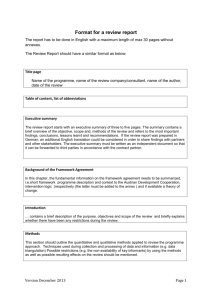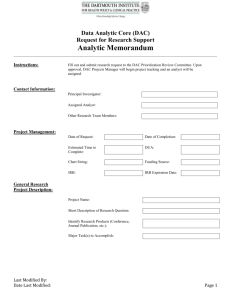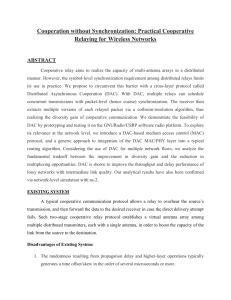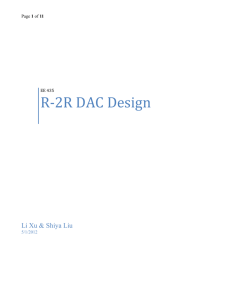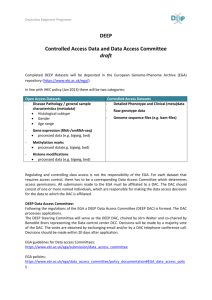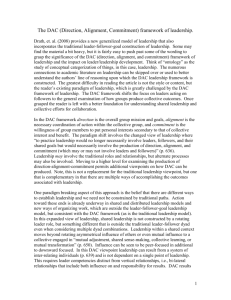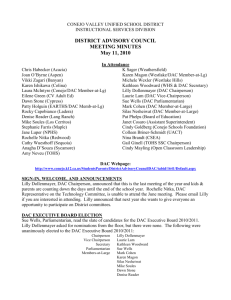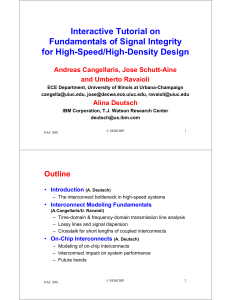MKID DAC Test Report
advertisement
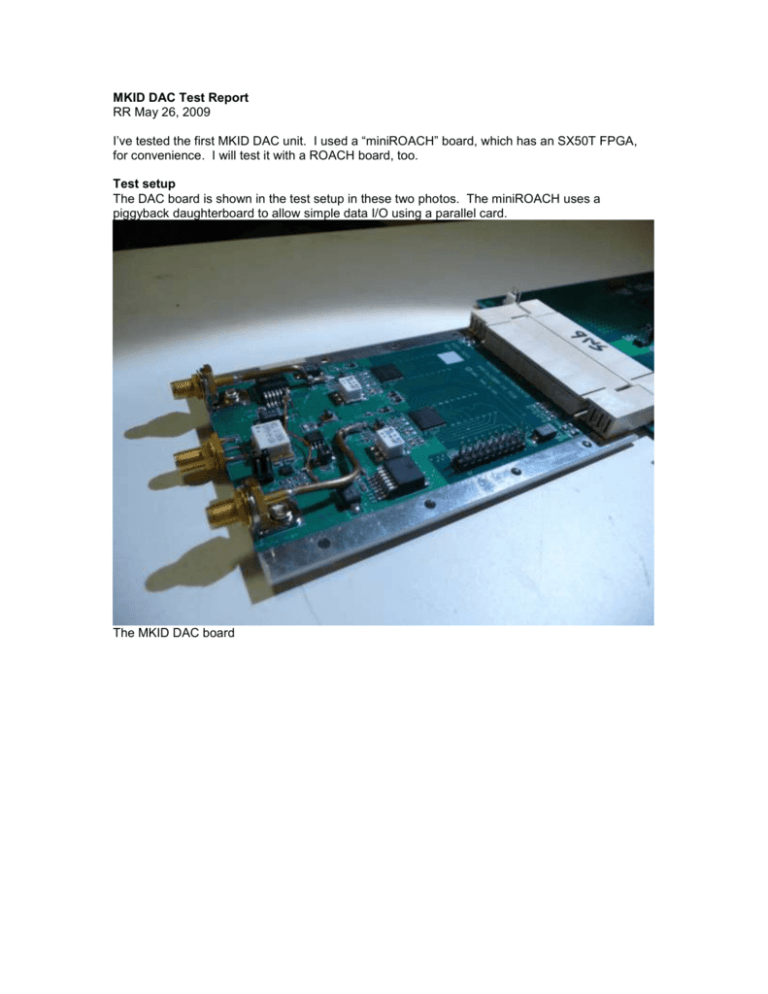
MKID DAC Test Report RR May 26, 2009 I’ve tested the first MKID DAC unit. I used a “miniROACH” board, which has an SX50T FPGA, for convenience. I will test it with a ROACH board, too. Test setup The DAC board is shown in the test setup in these two photos. The miniROACH uses a piggyback daughterboard to allow simple data I/O using a parallel card. The MKID DAC board DAC board plugged into “miniROACH” FPGA board. Test firmware. I wrote some Verilog code to generate sine waves at various frequencies and phases, and to allow setting of the DAC registers. A block diagram is shown here. The SINE LOOKUP ROMs each hold a single cycle of a sinewave in 256 samples of 16 bits resolution. The phase accumulator counter runs at ¼ of the sample rate, so 250MHz for a 1 GSPS rate. Each step of the counter generates an address into each of the four ROMS, separated by the settable constant FREQ. The ROM outputs are serialized by the OSERDES blocks to drive the DDR data lines. The generated frequency is then Fout = Fsample * freq/256, 0<= freq<= 127 (a setting of 0 causes a DC output, which will be removed by the output transformers). A settable “phase” quantity can be used to offset the counter’s reset value, and therefore introduce a shift of 0 to 1 cycle, in 256 steps. A four-wire serial interface allows the setting of those internal FPGA registers, and also the various DAC setup registers. The DAC register map is shown in this clip from the datasheet: A simple GUI allows setting of any of the registers I clocked the system with an HP6062A synthesizer, at +6dBm amplitude unless otherwise stated. Design problems There was one error in the design- the TPS74201 regulator requires a bias voltage larger than the +2.5v supplied in order to regulate at +1.8v. I fixed this by lifting pin6 of the regulator U7 and connecting it to +3.3 (the small red wire visible in the photo). Data transfer robustness. I did some testing at Fsample of 500MSPS, since the system is likely to be used at this clock rate, at least until faster ADCs are available. The DAC5681 datasheet specifies a setting for CONFIG10[3:0] of 1000b for this clock setting, and provides a 4-bit field (CONFIG10[7:4]) to vary the delay through the DCLK delay-locked loop (DLL). This is provided to allow adjustment of the clock-to-data phasing. I set the CONFIG10[3:0] bits as prescribed, and varied the CONFIG10[7:4] field over its full range to get an idea of the phase margin of the data transfer. I repeated this test at 1GSPS. The datasheet specifies CONFIG10[3:0] = 0000b for this clock setting. Results are summarized below, where an x indicates good data, an o indicates glitches or worse. Config10[7:4] Phase (deg) I, 500MSPS Q, 500MSPS I, 1GSPS Q, 1GSPS 8h 50 o x x x 9 55 o x x x A 60 o x x x B 65 o x x x C 70 o x x x D 75 o x x x E 80 o x x x F 85 o x x x 0 90 x x x x 1 95 x x x o 2 100 x x x o 3 105 x x x o 4 110 x x x o 5 115 x x x o 6 120 x x x o It’s interesting that the default setting of 00 works (barely) for both channels, and both sample rates. Frequency Response I used the oscilloscope’s FFT capability to measure the amplitude of the fundamental at various output frequencies and sample rates. Results in these plots, along with the sin(x)/x response of an ideal DAC. There is some significant excess attenuation at frequencies above 200MHz. I don’t know the source of these losses, maybe the output transformers. There is also some lowend rolloff at 10MHz due to the transformers. Freq Response, Fsample = 500MSPS 1 0 dB -1 -2 sinx/x, dB -3 I chan Qchan -4 -5 -6 0 50 100 150 Fout, MHz 200 250 7 125 x x x o Freq Response, Fsample= 1GSPS 1 0 -1 -2 sinx/x, dB dB -3 I chan -4 Qchan -5 -6 -7 -8 -9 0 50 100 150 200 250 300 350 400 450 500 Fout, MHz Output Amplitude The photo shows both outputs at Fsample = 1.0GSPS, FREQ=5 (so Fout = 1GHz * 5/256 = 19.53MHz), and with the DAC gain registers (CONFIG7[7:4]) at the default setting of 15 (full scale). Amplitude is about 900mvpp into 50 ohms. Crosstalk I tried two methods for measuring the crosstalk. First, I output a low frequency sine on one channel and a high frequency on the other, and used the scope’s FFT capability to look for the high-frequency component on the low-frequency channel. By this method, I estimate the crosstalk to be less than 60dB down. The second method is to set one channel’s output to zero frequency, while triggering on the high frequency sine from the other channel. By averaging and turning up the scope gain, I can see that any component of the high frequency that appears in the off channel is less than 100uV pp, or 80dB down from the 1v pp driven channel. I tried frequencies of 103.5, 207, and 402 MHz. Startup Synchronization The DAC5681 datasheet advises that multiple DACs may not start up in sync; there may be +- 1 sample clock cycle of skew between the two channels after a reset. I found this was true, and implemented a circuit to determine whether the two DACs are in sync, shown here. T3 samples a small bit of the signal from each channel; when the two are in phase, the signals cancel, and no voltage is developed across R32. When the signals are out of phase, a few mv appear across R32, which is detected by the comparator, causing PHASE to go high. If you program FREQ to 100 for both channels, generating a frequency of 100/256 * Fsample, ~ 40% of Fsample, then 1 cycle is 140 degrees of phase, and the voltage change across R32 is about 1.6mV, enough to reliably detect. The LMC7211 input bias current is negligible (40fA, even at elevated temperature), and the offset voltage drift of 1uV/C should allow reliable operation with just 500uV of margin. In practice, I found that the system starts up with the two channels in phase most of the time (though it could also be the case that other units will start up out of phase most of the time). A software or firmware routine to guarantee in-sync startup would repeatedly pulse the “DLL Restart” bit (in the DAC CONFIG8 register) and monitor the PHASE signal until it went low. In the case that the system repeatedly starts up out of phase, the DAC CONFIG1 register can be used to adjust DLL delay until PHASE goes low.


